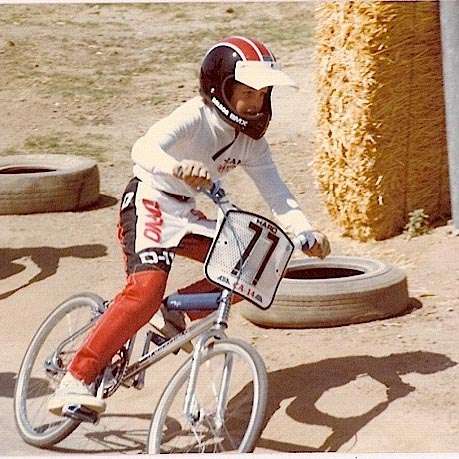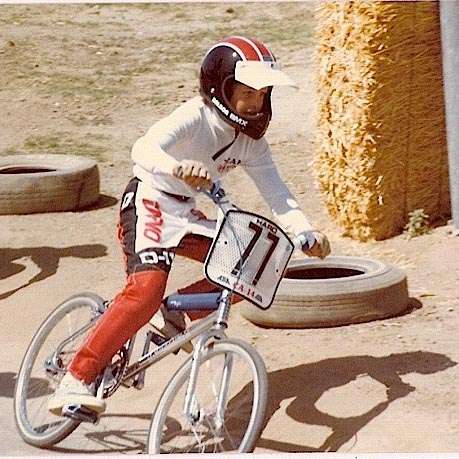In my 42-plus years as a bike racer, I’ve competed in a wide variety of cycling disciplines. It all began for me in 1975 on the BMX track. Racing 45-second races that required sprinting, technical skills, & mental toughness. Then in the early 90’s I started to dabble in the growing scene of mountain biking where I really didn’t know what I was doing or what the different disciplines entailed. I loved the downhill & dual slalom, but in the beginning, rode & trained more like I was going to be an XC racer. It was a learning experience, but one I had fun with & adjusted to pretty quickly. Over the years the desire for new challenges on two wheels grew, and I wanted to see what else I could achieve in other disciplines. Velodrome, cyclocross, road, XC stage races, sprint eliminator, enduro, all were tried at different levels. I loved learning how to race these different disciplines. Strategically, mentally, & physically they were all different and required different skills, but I usually figured it out. Adapting my workouts, mindset, strategies, equipment, surroundings, etc., I believe was a pivotal ingredient to succeed.

Racing 4cross/Dual Slalom was where I excelled the most. Blasting out of the start gate, railing berms, jumping big jumps and going head to head with other riders was exciting. Defending lines, looking for openings, absorbing a hit, it’s all apart of the fast-paced action that takes place in each 45-second bracket as you try and work your way through to the finals. A fast start & quick sprint were needed to do good in this discipline, along with fast-twitch bike handling skills to navigate the unexpected obstacles. But all that didn’t matter if you didn’t have the mental side on lock. When you’re lined up in the gate inches apart from 3 other riders, you better not only have the confidence in knowing you can beat them, but you also have to be able to handle the pressure & your nerves in these situations. A fraction of a second late out of the start and your #1 seed inside lane choice could have you being cut off from the rider to your outside, putting an early end to your chances of victory. Practicing starts, doing sprints, lifting for power and explosiveness & working on those skills that allow you to get over obstacles and around turns quickly are what you need. Having the ability to recover and be back to full strength for the next heat is the type of fitness required. A typical training week would look something like this:

Weekly Routine
- Monday – Heavy gym day (pyramid reps 8/6/4/2 increasing weight each set) plus an easy hour spin on the road
- Tuesday – 90min medium paced MTB ride
- Wednesday – BMX track 15-25 starts and first straight sprints
- Thursday – Explosive gym work out (lighter weight, higher reps 10-12) plus an easy hour spin on the road
- Friday – 90min road or MTB ride w/ 5 1min efforts, full recovery between each
- Saturday – 5 100-meter standing start sprints (decrease recovery time between each), fun jump session at trails
- Sunday – OFF


Physically it takes an entirely different athlete to succeed in XC, but strategically there are some similarities. When races are lasting 90-120 minutes, you have a lot more time to make moves happen than in a 4cross/DS race, but the importance of getting a good start is still essential. Try cramming 100+ riders from a 15ft wide trail into a single track. It’s doesn’t really happen very smoothly, and if you get caught back in 20th position, you could instantly find yourself 20-30seconds behind the leader. So starts are still crucial in XC races, just not quite at the same level as a 4cross/ds race. Another similarity is that you have to have areas on the track where you know you can make passes. You’re still battling head to head which requires reacting off moves other are making, as well as knowing when to make your own moves.
Endurance didn’t come easy for me since I spent all my life racing sprint events. I had to adapt my training, diet, and mindset to have any chance of doing well at the XC races I entered. Bike handling, power, sprinting, those were areas I knew I was most likely better than the others in these events. Sustained efforts, pacing, climbing, patience, these were all areas that I knew I needed to work on in my training. Instead of 10 sec efforts that were near 100% & 1 min efforts that were at 95%, I would do 2-3min efforts at 90% and 7-15min efforts at 90%. Gym workouts consisted of light weights and more reps only. Ride times/lengths increased and learning how my body reacted to these longer efforts helped me learn how to pace myself based on my fitness. Group training rides were a great race simulation form of training as your constantly having to react to what others in the ride are doing.
I was never the strongest or fittest XC racer, but I always tried to rely on my strengths & knowledge to do better than those who were most likely stronger. Attacking on the downhills would be a tactic that hopefully would cause other racers to make mistakes and stress on me pulling away. Taking more difficult lines that could save me time was another move that I always looked for. Allowing others to gain some distance on me before a section I knew I could quickly make up the distance right back because of my downhill, cornering, or line choice skills was one I learned to use often. Anything I could do makeup time or put distance on the others using less effort, I used to my advantage. I always knew if it came down to a sprint, and I had a little energy left I could most likely win, but learning to be patient was something I had to adjust too. With 4x/DS I always had the mindset of getting out front and going as hard as I could to the finish line. XC made me adjust that mindset and re-think how to approach these events.

When I officially retired from 4X & DS racing in 2008, I started competing in the growing sport of Enduro. A style of racing that was in some ways a cross between DH and XC racing. Having the fitness similar for XC you had to be able to put in 3-6hrs of riding in a day, but the intensity part was limited to the DH stages that were the only thing actually being timed. Again another discipline that required me to adapt my training to succeed.
The most important aspect of Enduro is being able to ride downhill trails fast, sometimes with very little knowledge of the trail. On the flip side, you have to have a fair amount of fitness to hammer down 5 stages in a day, while still managing an effort that could have you climbing 5k feet in that day. Unlike an XC race where depending on the course you could win with supreme fitness alone, in Enduro you won’t win by only having all the skill or all the fitness. Knowing I had a high level of skill & a fair degree of fitness, I believed I could make some adjustments to my training to be successful at an elite level in Enduro. I incorporated circuit workouts in the gym that would last 15+ min and tax the entire body. I tried to ride longer physical downhill trails and attack them as race runs. I’d put in longer efforts on the road bike where I could push myself further into exhaustion without the danger of being on a technical trail. I took every opportunity to go ride new places where I wasn’t familiar with the trails. I tested a lot of different wheel, tire, suspension, gearing setups to figure out combinations that would suit a wide variety of conditions depending on the courses we raced at. This preparation turned into a very time-consuming venture, as most things are when you are looking to be the best.
There was one major difference between Enduro & 4X/DS & XC racing which was you were only racing against the clock. No head to head battles, no gauging efforts or pacing off other riders, just an individual time trial that in some ways can be less stressful. The stressful part comes with trying to memorize so many stages & how you are going to attack the day. I personally found filming all the courses with my GoPro a great way to study them without the ability to ride them over and over. The more you can memorize a trail, knowing each corner and rock section, the more comfortable you will be going faster in these sections.


Each discipline that one wants to succeed in requires different preparation. And every athlete is different, so although some workouts, tactics, etc. work for some, doesn’t mean those will work for others. Some athletes may swim, run, ride moto, etc. as alternative methods of training. I personally found all three of these disciplines helped me improve my cycling in some way. The more well-rounded you are with your fitness and skill on the bike, the more options you will have to: take that tricky line; outsprint someone to the line; keep intensity high over a longer period of time, and attack-recover-and attack again. The more ammo in your arsenal the better. And that goes for your knowledge when choices have to be made. The more you have experimented with training methods, nutrition, equipment, terrains, climates, the better your decisions will be when you have to adapt to different situations.
What champions have that other outstanding athletes are lacking is mindset, awareness, and adaptability. The mind is really the difference between many talented athletes who compete and who win. You have to put in the work, but you have to really want and believe that you can be successful. It all comes down to confidence in yourself, your choices, your equipment, your preparation, your team around you. When you know everything has been done right and you believe that you are ready and can win, usually good things happen. Champions know how to adapt to whatever is put in front of them and overcome most challenges.






Comments